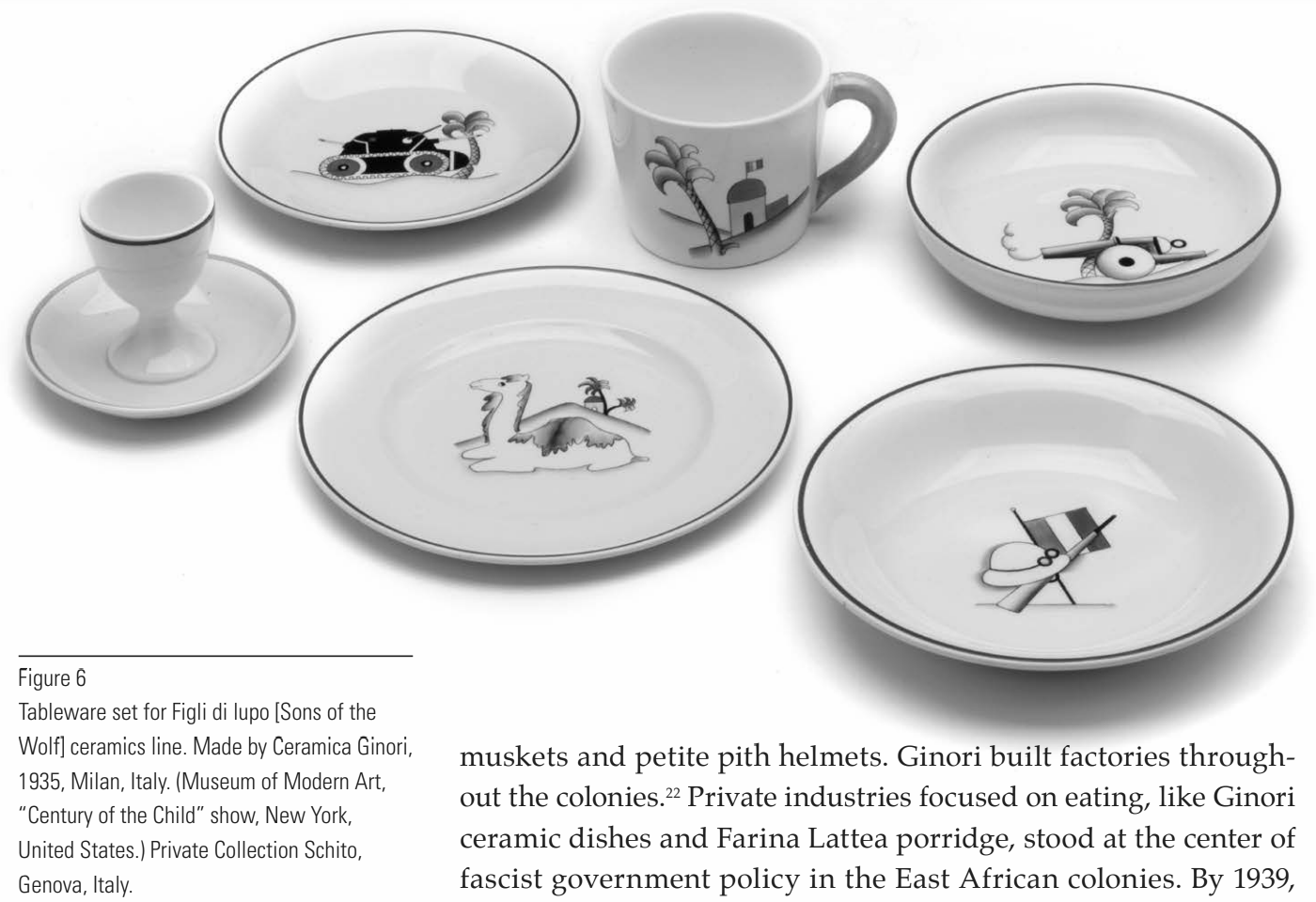Although futurist artists first pioneered the idea that Italian toys ought to “accustom the child to… physical courage, struggle, and WAR,” the Italian toy industry under fascism adapted these ideas to the new political moment.¹¹ They made use of régime projects in their product designs, miniaturizing the world of fascist adults to create attractive commercial items. As a result, private companies often designed more effective propaganda for fascism than the régime.
Playing with fascism:
The Conquest of Abyssinia, Farina Lattea Erba’s imperial board game, invited children to walk in the footsteps of fascist foot soldiers and the Italian industrial titans who came before them (see Figure 5). Illustrations of steam ships, palm trees, and [Fascist] military progress were printed in bright color lithograph on heavy cardboard stock by Officina Istituto Italiano d’Arte Grafica Bergamo.
This tabletop amusement for children represented a significant advertising investment on the part of Carlo Erba S.A., the Milanese food company. Measuring two feet by one foot, it would have dominated the table as children played the game at breakfast (presumably consisting of the cream of wheat hawked by the company). Carlo Erba S.A. provided this toy in omaggio, the gift that came with a number of porridge box purchases.
[…]
Italian children could even eat their morning cream of what out of a 1935 line of colonial dishware from ceramics maker Ginora, called “Figli di Lupa” (see Figure 6). These tiny cups and plates showed camels, palm trees, and huts alongside the cannons, tanks, and guns used to take them. Key to the construction of children’s racism, this reduction in scale conveys an empire that you can hold in the palm of your hand. Advertising and illustration reduced the actual violence to miniaturized play.
(Emphasis added in all cases.)
I am including a screenshot in this excerpt because you really have to see these to believe them:

Concerning German Fascism, this information comes from Mary Flanagan’s and Mikael Jakobsson’s Playing Oppression: The Legacy of Conquest and Empire in Colonialist Board Games, pages 74–75:
During the rise of the Nazi Party (or its full name, the [so-called] National Socialist German Worker’s Party) […], toys and games were used to promote a growing fascist ideology. German public messaging for pro-Hitler stances began in earnest in the 1930s, using a multipronged approach to appeal both to adults and to children as part of the [Fascist bourgeoisie’s] ideological machine.
In the early twentieth century, Germany was the world leader in children’s toy production, churning out toy soldiers, play weapons, cannons, airplanes, battleships, and board games up until [September 1939].²¹ The production of games and toy soldiers in Germany peaked in the [Fascist] era, when record numbers of Elastolin figures (literally, three million little green army men) were produced. [The Third Reich] excelled in the production of military-related amusements.
Presenting a world with norms and values and generating player mindsets are things board games do very well, and they proved to be useful ways to enculturate youth through the [Fascist] propaganda machine. The [Fascist bourgeoisie] controlled all media—newspapers, books, magazines, theater, radio, films, and toy production—and created a plethora of board games, most of which are now lost because they were destroyed after the war by law. Extant examples are either in museum collections or in the hands of private paper and ephemera collectors.
Popular [Fascist] games included board games depicting the everyday life of soldiers, such as Oh, welche Lust Soldat zu sein! (Oh, what fun to be a soldier!, 1937), Hitler’s program for constructing the autobahns Die Reichsautobahnen (The Reich’s autobahn, 1938), Volk ans Gewehr (People at arms, 1938), and Das Große Belagerungsspiel (The great siege game, 1939); the war-themed board games often featured swastikas and nationalist imagery. Flieger Alarm! (Airmen alert!, 1942) featured scenes from both military and domestic life. A 1939 game, Radio Sende Spiel (Radio broadcast game), featured a radio network. Mit “Prien” gegen England (With “Prien” against England, 1940), an anti-England game framed around the infamous U-boat commander Günther Prien, featured players as submarines sinking Allied ships.²² The [Fascist] production Jagd auf Kohlenklau (Hunt for coal theft, 1944) was part of a propaganda campaign launched in 1942 to use games to encourage tighter social control. In this case, players hunt down the thief among them who has hoarded wartime resources.
[Fascist]-era propaganda influenced children and the public against people of Jewish descent in insidious ways, promoting anti-Jewish sentiment and making it an everyday norm in books, films, and radio, and especially in toys and games. Compared to posters, postcards, or comics—all used to message to children—the time that players invest in games, the ability of games to engage the imagination and fantasy, and games’ ability to set norms for groups playing together all played a part in the choice of board games as particularly apt [Fascist] propaganda tools.
Alongside the government-sponsored propaganda, German manufacturers themselves used the national anti-Semitic atmosphere to promote game sales. The Günther & Company game Juden Raus! (Jews out!, 1936), for example, infamously depicted the discrimination against, and deportation of, Jewish people and is described by the game studies scholars Andrew Morris-Friedman and Ulrich Schädler as “history’s most infamous board game.”²³
It was, indeed, a commercial game that tasked players with moving Jewish members of a town out of the city limits and then sending Jews off on trains (presumably to camps).²⁴ Many other [Fascist] games depicting anti-Jewish activities and sentiments likely existed, which in turn influenced broader cultural discourses, further normalizing anti-Semitism.
(Juden Raus! was apparently a critical and commercial failure, unlike the Adolf Schicklgruber sticker album.)